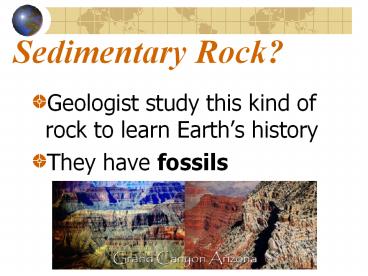Sedimentary Rock? - PowerPoint PPT Presentation
1 / 47
Title:
Sedimentary Rock?
Description:
Sedimentary Rock? Geologist study this kind of rock to learn Earth s history They have fossils – PowerPoint PPT presentation
Number of Views:92
Avg rating:1.0/5.0
Title: Sedimentary Rock?
1
Sedimentary Rock?
- Geologist study this kind of rock to learn
Earths history - They have fossils
2
Earthquakes!!!!
- Occur when there is movement of the Earths crust
along plate boundaries.
3
Electrical circuits can be made using
- 1) a battery
- 2) a copper wire
- 3) a light bulb
- 4) and something else to complete the circuit,
like an iron nail.
4
Magnets have a North and South pole.
- Dont forget opposites attract!!
5
The sun is the closest star to our Earth.
- The sun is the source of energy that all
organisms need to survive.
6
Circulatory System
- Transports nutrients and oxygen in humans.
7
What is sequence that shows the levels of
organization for structure and function in a
human?
- Cell- tissue-organ-organ system
8
Endocrine System
- The system of the human body that controls the
production of hormones that regulate our body
functions.
9
The skeletal system includes
- The skull, the spinal column and the ribs.
10
Hibernation occurs
- When animals need to avoid harsh conditions, such
as extremely cold weather.
11
An adaptation
- A characteristic or trait that allows an animal
to survive in its environment. - 1. A reflex
- 2. A response
- 3. An adaptation
12
What are rocks?
- They are combinations of minerals
13
Herbivores
- These animals get their energy from plants only
14
Weather
- An air mass moving into the region where you live
will change the ___. - season, weather, time
15
Reproductive System
- This system is responsible for the making of
- offspring
16
Brain
- This organ controls everything you do...
17
precipitation
- Moisture that returns to the earths surface from
the atmosphere.
18
erosion
- The transport, moving, of sediments from one
place to another by wind, water, glaciers, and
gravity.
19
Excretory System
- This body system removes liquid and gaseous wastes
20
Muscular Nervous System
- Which 2 body systems work with the skeletal
system to move the body?
21
Photosynthesis
- The process where a plant makes its food using
- -energy from the sun
- -Water
- -Carbon Dioxide
- -Chlorophyll
22
Carnivores
- Animals that only eat other animals (meat)
23
Producers
- Green plants are organisms that make their own
food, they are called - consumers, producers, or decomposers
24
Alveoli
- Thousands of tiny air sacs in your lungs, which
exchange Oxygen for Carbon Dioxide - cilia
- alveoli
- mucus
25
Decomposers
- Organisms, such as insects, fungi, and bacteria,
that eat dead and decaying material. - consumers, producers, or decomposers
26
Warm-blooded
- The animals body temperature does not change
when the surrounding temperature changes.
27
Water, carbon dioxide, energy from the sun,
chlorophyll
- Name the four ingredients for the process of
photosynthesis
28
leaves
- What part of the plant makes food?
- stem
- leaves
- roots
29
Heredity
- In all organisms, genetic traits such as
freckles, eye color, or a dimple are passed on
from generation to generation. - This is called
30
Calories
- Energy in foods is measured in ____.
31
Digestive System
- The food tube
- Stores Bile
- Food is churned here
- Stores nutrients
ESOPHAGUS
GALL BLADDER
STOMACH
LIVER
32
Adapt
- If an animal can not migrate or hibernate to
avoid harsh weather conditions, then it must - die
- adapt
- sleep
33
Predators, Carnivores
- What kind of mammals have long, sharp pointed
teeth?
34
Weathering
- The wearing away or breaking down of sediments by
wind, moving water, and glaciers.
35
The sun
- What is the closest star to planet Earth?
36
lithosphere
- This is the hard, solid part of the earths crust
- atmosphere
- troposphere
- lithosphere
37
Gravity
- The force that keeps planets in orbit around the
Sun and the Moon in orbit around the Earth.
38
Rotation
- The Sun appears to move across the sky each day.
Its rising and setting each day can be explained
by the Earths _____.
39
Body System
- A group of organs that work together is called a
_______
40
veins
- We take blood to the heart
41
White Blood Cells
- We destroy bacteria which invade the body.
42
Respiratory System
- Nose, mouth, trachea, lungs, alveoli are all part
of the _______ system.
43
alveoli
- They take in the carbon dioxide from blood
vessels in your lungs, then release oxygen. (Tiny
Air Sacs) - This is where CO2 is exchanged for Oxygen.
44
front
- This is where two different air masses meet.
45
Iris
- The colored part of your eye
46
Earths Tilt Revolution
- What causes the seasonal changes on Earth?
47
Ocean Tides
- The Moon has the greatest effect on Earths ___.































